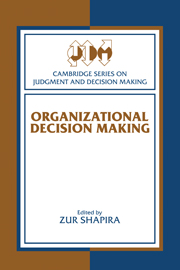Book contents
- Frontmatter
- Contents
- Series preface
- List of contributors
- Editor's preface
- Part I Introduction
- Part II Information processing and attention allocation
- 3 Trying to help S&Ls: How organizations with good intentions jointly enacted disaster
- 4 Organizational choice under ambiguity: Decision making in the chemical industry following Bhopal
- 5 Strategic agenda building in organizations
- Part III Preference processing
- Part IV Decision processes
- Part V Alternative approaches
- Name index
- Subject index
4 - Organizational choice under ambiguity: Decision making in the chemical industry following Bhopal
Published online by Cambridge University Press: 06 August 2010
- Frontmatter
- Contents
- Series preface
- List of contributors
- Editor's preface
- Part I Introduction
- Part II Information processing and attention allocation
- 3 Trying to help S&Ls: How organizations with good intentions jointly enacted disaster
- 4 Organizational choice under ambiguity: Decision making in the chemical industry following Bhopal
- 5 Strategic agenda building in organizations
- Part III Preference processing
- Part IV Decision processes
- Part V Alternative approaches
- Name index
- Subject index
Summary
Introduction
Organizational decision making would be a relatively simple matter if probabilities could always be estimated and objectives were clear and consistent. Under those conditions, a decision maker could systematically compare and evaluate alternative courses of action with ease. These are not the conditions in the world of modern business, however. Most important, organizational decisions today are made under clouds of ambiguity.
In this chapter we examine how managers in the chemical industry made a set of particularly difficult decisions under ambiguity. Specifically, we explore how several large chemical firms made choices related to reducing the chances of catastrophe following the December 1984 Bhopal disaster. The Bhopal explosion, in which a release of methyl isocyanate from a Union Carbide India plant killed 3,000 people and injured tens of thousands (Shrivastava, 1987; Steiner, 1991), profoundly affected the chemical industry. It led the entire industry to reassess its approach to dealing with low-probability, high-consequence (LP-HC) risks, which are at once intrinsically ambiguous and enormously frightening.
To set the stage for our analysis of ambiguity, we describe, in Section 4.2, how a decision-analytic approach deals with choices among alternatives when probabilities, outcomes, and preferences are not ambiguous. In Section 4.3 we describe types and sources of ambiguity and explore some of their effects on organizational choices. In Section 4.4 three case studies illustrate how ambiguity affected decisions by chemical firms faced with LP-HC risks.
- Type
- Chapter
- Information
- Organizational Decision Making , pp. 61 - 80Publisher: Cambridge University PressPrint publication year: 1996
- 1
- Cited by



